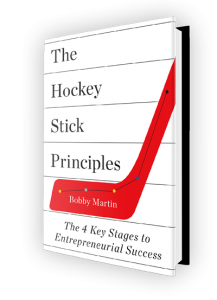The Hockey Stick Principles
Chapter 2
Skating on Thin Ice: Raising Seed Capital to Get Started
Many founders launch their start-ups with the expectation that they’ll begin to earn income from the business not long after going to market. This is a big mistake. One of the most common misconceptions about building a start-up is that once you launch, you’ll be able to pay yourself a good—or at least an adequate—salary either out of your revenue or out of capital raised. The truth is that very often, revenue is not enough to cover expenses well into the blade years—often three years—and that getting the business solidly into growth mode usually requires that the lion’s share of earnings and of any capital raised be invested back in the business. This money should go toward paying for increasing operating expenses, such as salaries for employees and office space; to make product improvements; to do more marketing and advertising; to maintain the product; and to expand operations. You should plan to reinvest in the business rather than pay yourself a desirable salary even when revenues are quite healthy.
Don’t Plan on Paying Yourself
Take the case of my brother-in-law Brad McCorkle, which is a pretty typical experience for entrepreneurs. He started his company when he was thirty-six years old and was married with two young children, so he had several mouths to feed, and he hadn’t been saving up for launching a business. He wasn’t expecting to become an entrepreneur, but he seized a good opportunity when he saw it.
Brad was working as a salesman of ophthalmic drugs, which treat ailments of the eyes, and when his employer, Alcon Labs, wanted him to relocate to become the manager of a sales territory, he decided that he didn’t want to move his family. Instead, he left Alcon and started Local Eye Site (LES), a Web-based service that connects eye care practices with job applicants, which was the first of its kind. He had determined that Monster.com and the other job boards weren’t doing their job in the eye care business be-cause his clients often asked him to help them find new employees.
To get started, Brad raised $60,000 from two angel investors to build the LES site and a sophisticated recruiting tool. One angel was a well-connected leader in the eye care industry, and I was the other. Brad made a full-time commitment to the business and owned 51 percent of the firm. He used none of this seed money to pay his living expenses, instead drawing from his savings for those, and as his revenue slowly grew over the next several years, he started to pay himself a very small salary. Even when revenue grew to $429,000 in the third year, he continued to dig into his savings to pay his family’s living expenses and poured most of that revenue right back into the business.
This may seem foolish, but one of the important truths of achieving start-up success is that being willing to continue to put all earnings and capital raised into fueling growth is often the differentiator in getting your business to take off. So founders must plan on this. It’s true that some start-ups do manage to generate enough cash from sales early on to provide a good flow of founder income while also investing adequate funds into growth, and in a bit, we’ll discuss great models for generating cash up front and a predictable future cash flow, but even in these cases, pulling in an adequate pool of first customers may take quite some time. Meanwhile, raising outside capital is much more difficult than most founders predict. The result is that far too many end up raiding their personal finances and drowning their prospects for success in overwhelming debt.
So often, founders anticipate they’ll have to work for no or low pay for six or maybe as long as twelve months, but that stretches out to twenty-four months or longer. Keep in mind that the Hockey Stick study found that the average time from starting a company to growth takeoff was three to four years. Not anticipating the financing challenges of this period means that far too many founders are forced to abandon a business that might have great potential because they’re broke and have maxed out all of their credit cards.
It’s vital not to plan to pay yourself a sizeable salary from either earnings or financing for the duration of the blade years, and do not delude yourself about how long these lean times will last.
Financial projections to help you navigate through this phase are important, and you should definitely calculate detailed ones. But they’re likely to change. Product delays and redesigns are the rule, no matter how well you’ve planned, and they always cost something, whether in more out-lays or loss of sales. When we started Vertical IQ, our first interface was confusing and had to be completely redone, delaying launch by three months. That mistake cost us roughly $20,000 that we’d originally projected from advance sales I’d made, so suddenly our operating budget was much tighter.
